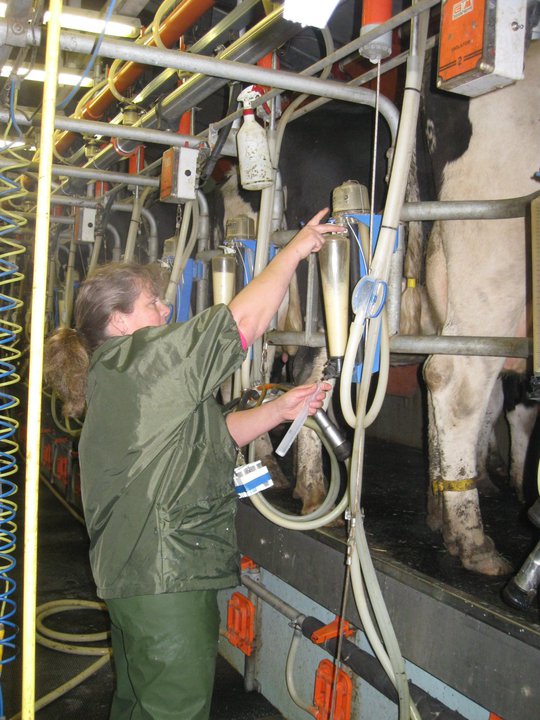Sam is a 46 year old married mother of two teenage boys. When she left school she worked on dairy farms rearing calves and relief milking. She gave it up when she started a family and worked part time in the family company’s accounts department. She couldn’t get the cows out of her system though, so when she saw an ad in a local paper for a Milk Recorder she went for it. Her sons were at secondary school by this point and she was bored at home so it seemed to make sense.

This is a day in Sam’s life as a milk recorder.
I work for a company called National Milk Records (NMR). NMR is the leading supplier of milk recording services in the UK, providing management information on individual cows’ performances in terms of milk quality, yield and fertility.
I have started my “recording day” at lunchtime as this is how I would record one farm.
I have a supply of sample pots delivered to my house every month. These lovely orange boxes contain 60 sample pots which i have to number up before we can start milking. Most of my farms now have computers so at some stage before I am due there, they send me an email with all the data I need. This is everything that has happened to the cows since I was there last month. When I’ve put all of these “events” (such as calving, illness, death or sales) into my laptop I can then work out which cows will be coming in to be milked that afternoon.
I write the numbers (each cow has a number) on the pots, load them into the car and go to the farm. In theory my list should match exactly to the cows in the herd, with the odd exception where a cow has had an “event” before I get there, such as mastitis or lameness.
At the farm it’s on with the wellies and waterproofs. It’s usually a messy job though in high summer I can get away with shorts and flip flops at a couple of farms. Through the winter I tend to look more like a Michelin man!
As the cows come into the parlour I take their number (hopefully I can read their freeze brand; if not I have to try and read her ear tag). I pick out the corresponding pot for each cow and take a small sample of milk.
There are various different types of sampling system, but they all syphon off some milk while the cow is being milked, into a bottle or a pot. I also write down how much milk each cow has given. This is weighed in kilograms, and it’s not unusual for a cow to give 100 tonnes of milk in her lifetime – something I still find staggering to this day! A cow will on average give about 25kg of milk per day; some more, some less.
The average time I am at a farm in the afternoon is 2.5 hours. Then it’s home to cook tea, feed dogs, sort washing and all the other things that need to be done before bed.
At 4am it’s up and at it again. Early mornings don’t bother me, although for one farm I have to be up at 2:30am which does push it to the limit! I need coffee, so I have one before I leave and make a flask to take with me. I usually put the dishwasher on and load the washing machine before I go so that they are finished when I get home. It’s too early to eat anything at 4am though, so I sometimes take a banana or a breakfast biscuit to eat when we’ve finished the milking.
On the farm I repeat what was done yesterday so that we get a true sample of 24 hours’ worth of milk. At the end of milking I check that all the pots have milk in them, and remove any that are empty. I record the milk yields onto my computer and print off a record of that day’s milking for the farmer. This will have all the data on it including yields, service dates, calving dates and pregnancy test reslts. A full report, including test results, will be available to the farmer within 3 or 4 days online.
I leave the samples on the farm so that they can be collected by the tanker driver and sent on to our laboratory in Wolverhampton. There the milk is tested for quality, butterfat, protein and in some cases some diseases that can affect the cows. We can now also pregnancy test the cows through their milk sample.
Back at home I double check that what I’m sending on the computer matches what I have left on the farm, and upload the information to a central server. Depending on what day it is, I’ll download the data for my next couple of farms and sort out that afternoon’s herd at the same time.
Once I’ve had breakfast, let the chickens out, walked th edogs and had a shower it’s off to my “day job” in the office for a few hours where I sort invoices and generally input data into a different system!

2 Comments
debbie barlow · 17/06/2016 at 15:51
loved your description of being a milk recorder Sam.
Im thinking of applying to do the job and your blog really explained the job well.
Louise Ricketts · 06/11/2016 at 13:58
I loved reading about Sam’s day. My father was a milk recorder for a few years when I was a small child. Sometimes he would take me with him in the car but he would not let me get out at the farms which used to annoy me but I now understand why.
I was always rather vague about what his job entailed. This has helped me understand.
Of course he did not use computers. This was the 1950’s. Thank you for the info.